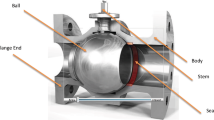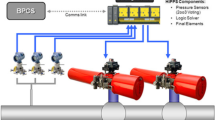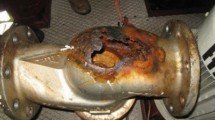Abstract
This paper reviews the most common type of check valves: swing, dual plate and nozzle. The pros and cons of each choice will be explained in this review, which can be used as a basis for making the most suitable check valve selection for installation after rotating equipment such as pumps and compressors. Dual plate check valves are compared to nozzle check valves in terms of pressure drop and water hammering. The process and valve information in two case studies are based on two recent Norwegian offshore projects. Dual plate check valves show more than twice the pressure drop and more than three times the water hammering effect in the form of applied pressure to the piping system compared to nozzle check valves. Thus, nozzle check valves are proposed as the best choice for use after pumps and compressors. The most important risk that causes nozzle check valve failure during operation is chattering; this occurs when the fluid can not keep the valve in fully open position and causes wear and tear inside the valve. The second case study of a nozzle check valve in a recent Norwegian project is reviewed in which the minimum flow in the piping system can not fully open the valve. Different solutions such as reducing the size of the valve, reducing the spring torque behind the valve seat and increasing the minimum flow are proposed in this paper. In addition, high fluid velocity is considered as another operational problem that leads to wear and tear of the valve as well as valve failure. Adjusting the narrow area inside the nozzle check valves can reduce the velocity inside the valve to an acceptable limit.





Similar content being viewed by others
References
P. Smith, R.W. Zappe, Valve Selection Handbook, 5th edn. (Elsevier, New York, NY, 2004)
K. Sotoodeh, Comparing dual plate and swing check valves and the importance of minimum flow for dual plate check valves. Am. J. Ind. Eng. 5(1), 31–35 (2018). https://doi.org/10.12691/ajie-5-1-5
Norwegian Oil Industry Association, Valve Technology. Norsk olje and gass, 2nd revision (2013)
A. Kruisbrink, The need for dynamic characteristics of check valves. Valve World Mag. 15(09), 65–66 (2010)
VALMETALIC, Design and selection of check valves. https://www.valmatic.com/Portals/0/pdfs/DesignSelectionCheckValves.pdf. Accessed 5 June 2020 (2018)
G. Oxler, Non-return valve and/or check valve for pump system-a new approach. Valve World Mag. 14(04), 75–77 (2009)
J.V. Ballun, A Methodology for Predicting Check Valve Slam. (American Water Works Association (AWWA), Denver, 2007)
H. Schmitz, What is water hammer and how do I fix it? Livintanor. https://livinator.com/whats-water-hammer-and-how-do-i-fix-it/. Accessed 6 June 2020 (2018)
American Petroleum Institute (API) 594. Check Valves: Flanged, Lug, Wafer and Butt-welding, 6th edn. Washington, DC (2004)
NORSOK L-001. Piping and valves. Revision 4. Norway, Lysaker (2017)
TR2000. Piping and valve material specification. Equinor. https://www.tr2000.no/TR2000/index.jsp. Accessed 7 June 2020
K. Sotoodeh, Axial flow nozzle check valves for pumps and compressors protection. Valve World Mag. 20(1), 84–87 (2015)
R. Ford, Power industry applications: a valve selection overview. Valve World Mag. 19(8), 96–103 (2014)
H. Gustorf, P. Root, Developments in axial valve design. Valve World Mag. 21(10), 49–53 (2016)
K. Sotoodeh, Challenges associated with the bypass valves of control valves in a seawater service. J. Mar. Sci. Appl. (2020). https://doi.org/10.1007/s11804-020-00132-8
K. Sotoodeh, Valve selection for bypass of control valves: a case study. http://www.valvemagazine.com/web-only/categories/technical-topics/9454-valve-selection-for-bypass-of-control-valves-a-case-study.html. Accessed on 10 Jun 2020 (2018)
B. Nesbitt, Handbook of Valves and Actuators, 2nd rev. (Elsevier, Oxford, 2011)
G.A. Provoost, The dynamic characteristic of non-return valves, in Conference paper submitted to 11th symposium of the section of hydraulic machinery, equipment and cavitation. Netherlands (1982)
VALMETALIC, Dynamic characteristics of check valves. https://www.valmatic.com/Portals/0/pdfs/DynamicCharacteristicsofCheckValves_18.pdf. Accessed 11 June 2020 (2018)
NORSOK P-001, Process design, edition 5 Lysaker Norway (2006)
CRANE flow energy solutions. Calculations and analysis for dual plate and axial flow check valves. Rev. 03 (2015)
Engineering ToolBox. Pipe class rating and pressure numbers (PN). https://www.engineeringtoolbox.com/flanges-pn-pressure-ratings-d_46.html. Accessed 13 June 2020 (2003)
The American Society of Mechanical Engineers (ASME B16.34), Valves flanged, threaded and welding ends. USA. New York (2017)
The American Society of Mechanical Engineers (ASME B16.05)), Flanges and bolt dimensions Cl150 to 2500. USA. New York (2017)
AkerSolutions, Special item data sheets for non-slam axial flow check valves. Rev. 03 (2015)
Goodwin International Ltd, Pressure drop and line velocity calculation sheets for liquid services. Rev. 1 (2018)
Acknowledgments
I would like to express my gratitude to my partner, Tamara Zhunussova, for her constant support.
Author information
Authors and Affiliations
Corresponding author
Additional information
Publisher's Note
Springer Nature remains neutral with regard to jurisdictional claims in published maps and institutional affiliations.
Rights and permissions
About this article
Cite this article
Sotoodeh, K. Analysis and Failure Prevention of Nozzle Check Valves Used for Protection of Rotating Equipment Due to Wear and Tear in the Oil and Gas Industry. J Fail. Anal. and Preven. 21, 1231–1239 (2021). https://doi.org/10.1007/s11668-021-01162-2
Received:
Revised:
Accepted:
Published:
Issue Date:
DOI: https://doi.org/10.1007/s11668-021-01162-2




